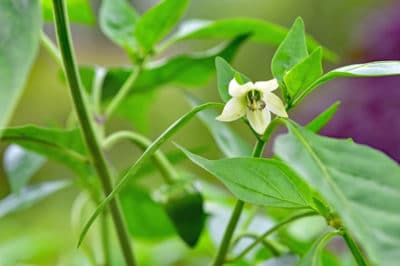Botany
Capsicum is a genus of plants in the family Solanacaea. They are native to The Americas and include many different plant species, about 5 of which have been domesticated. Capsicum annum is the most commonly grown domestic species and it includes familiar fruits like:
- Bell Peppers
- Jalapenos
- Cayenne
Pepper flowers appear in early summer. They are white to slightly purple in color and hang in a bell-like fashion. The flowers are perfect, meaning they have all the reproductive organs in each flower. The flower will pollinate itself but can be helped along by bees, wind, and the occasional human hand.
Hand Pollination
Even though pepper flowers can pollinate themselves, those grown indoors or in a greenhouse may need a helping hand. All pepper plants can be hand-pollinated. Those indoors may not get enough draft to knock the pollen off of the anther to the stigma. the benefits of hand-pollinating include knowing that the pollination was pure to type and that each flower will produce a fruit.
Pollinate pepper flowers with a small makeup brush or cotton-tipped swab. Simply swab the inside of any flower to get the pollen stuck to your brush. Go from flower to flower swirling your brush or swab around to get the pollen all over the central stigma, which is the female organ of the flower.
Blossom Drop
Pepper plants that endure various stresses sometimes lose blossoms before they pollinate or fruit, causing your pepper plants to remain in an eternal vegetative growth stage. The most common cause of blossom drop is temperature. Peppers plants like a temperature range of 70-80°F (21-26°C). Consistent or routine extremes of cold or hot will stress pepper plants eventually to the point of causing blossom drop.
Humidity can play a role in triggering flower loss in peppers. Peppers are from the tropics, but can also suffer from too much humidity. The optimum range for peppers is between 35-70%.
Other reasons for blossom drop include poor pollination and improper care. Blossoms that aren’t pollinated will drop and then produce no fruit leading the gardener to point to blossom drop as the issue. This problem is more likely in greenhouses or hydroponic systems that do not have enough draft to blow the pollen.
Peppers require a strict watering schedule and will suffer from both dry and wet extremes. Avoid over-fertilizing peppers especially with nitrogen heavy salts. Organic compost is the best way to feed pepper plants.
